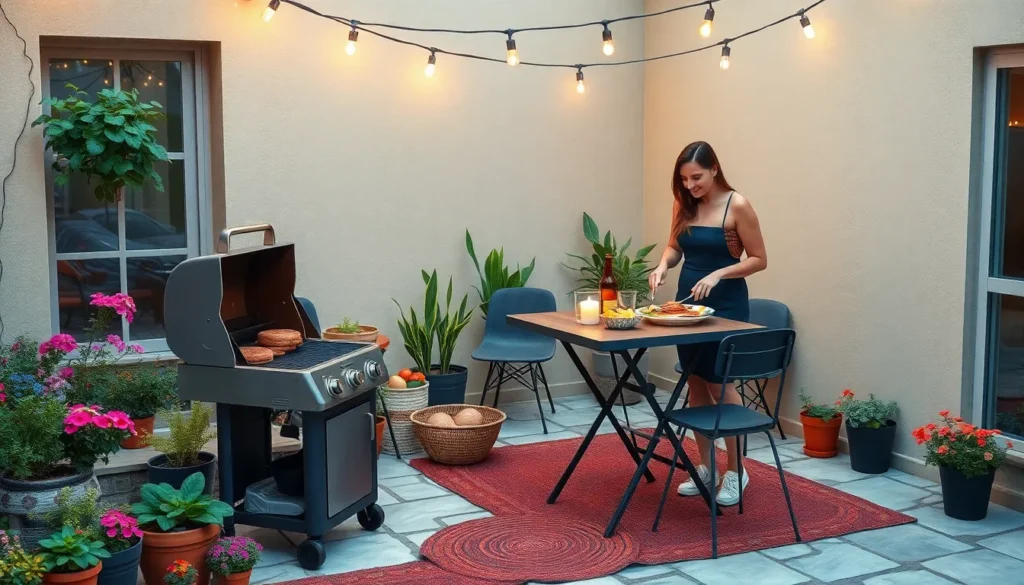Creating the perfect BBQ area in a small garden doesn’t require acres of space – it just takes smart planning and creative design choices. We’ve discovered that even the tiniest outdoor spaces can transform into stunning entertaining hubs that’ll make your neighbors envious.
Whether you’re working with a compact backyard, narrow patio, or cozy courtyard, we’ll show you how to maximize every square foot. From space-saving grilling stations to clever storage answers, these innovative ideas prove that size doesn’t matter when it comes to outdoor cooking and dining.
Ready to turn your small garden into the ultimate BBQ destination? We’ve compiled the most effective design strategies, budget-friendly DIY projects, and space-maximizing tips that’ll help you create an outdoor cooking paradise – no matter how limited your square footage might be.
Create a Dedicated BBQ Zone with Compact Grilling Stations
Establishing a designated grilling area transforms your small garden into a functional outdoor kitchen. We’ll explore three effective approaches to create your perfect compact BBQ zone.
Choose Space-Saving Portable Grills
Portable grills offer the ultimate flexibility for small garden BBQ areas. These compact units typically measure 20-24 inches wide and can easily move between different locations in your outdoor space.
Electric grills work exceptionally well for small patios and balconies since they don’t require propane tanks or charcoal storage. Models like the Weber Q1400 provide 189 square inches of cooking space while weighing only 31 pounds.
Tabletop gas grills deliver restaurant quality results without permanent installation requirements. We recommend units with 200-300 square inches of cooking surface that accommodate 4-6 people comfortably.
Kettle grills in 18-inch sizes provide authentic charcoal flavor while fitting into tight corners. They stack vertically when not in use and store easily in garden sheds or garages.
Install Built-In Mini BBQ Units
Built-in BBQ units maximize cooking space while minimizing your garden’s footprint. Custom masonry units typically require only 4-6 square feet of ground space.
Drop-in grill inserts fit perfectly into existing countertops or custom-built stations. Standard 24-inch inserts provide ample cooking surface for small gatherings while maintaining a streamlined appearance.
Fire brick construction creates durable BBQ stations that withstand weather extremes. We suggest building units 30-36 inches high for comfortable cooking without bending.
Modular BBQ systems allow you to add components over time as your budget permits. Basic starter units include a grill insert plus storage compartment for utensils and supplies.
Use Corner Spaces for Maximum Efficiency
Corner installations make the most of your available garden real estate. L-shaped configurations provide prep space on one side and grilling area on the other.
Triangular grill stations fit snugly into 90-degree corners while offering 270-degree access around the cooking surface. These designs typically require only 3-4 feet of wall space on each side.
Corner storage answers keep BBQ accessories organized and easily accessible. Built-in cabinets underneath grill surfaces store propane tanks, charcoal bags, and cooking utensils.
Wraparound countertops create additional workspace for food preparation and serving. We recommend extending counters 12-18 inches beyond the grill on each side for optimal functionality.
Design Multi-Functional Outdoor Cooking Areas
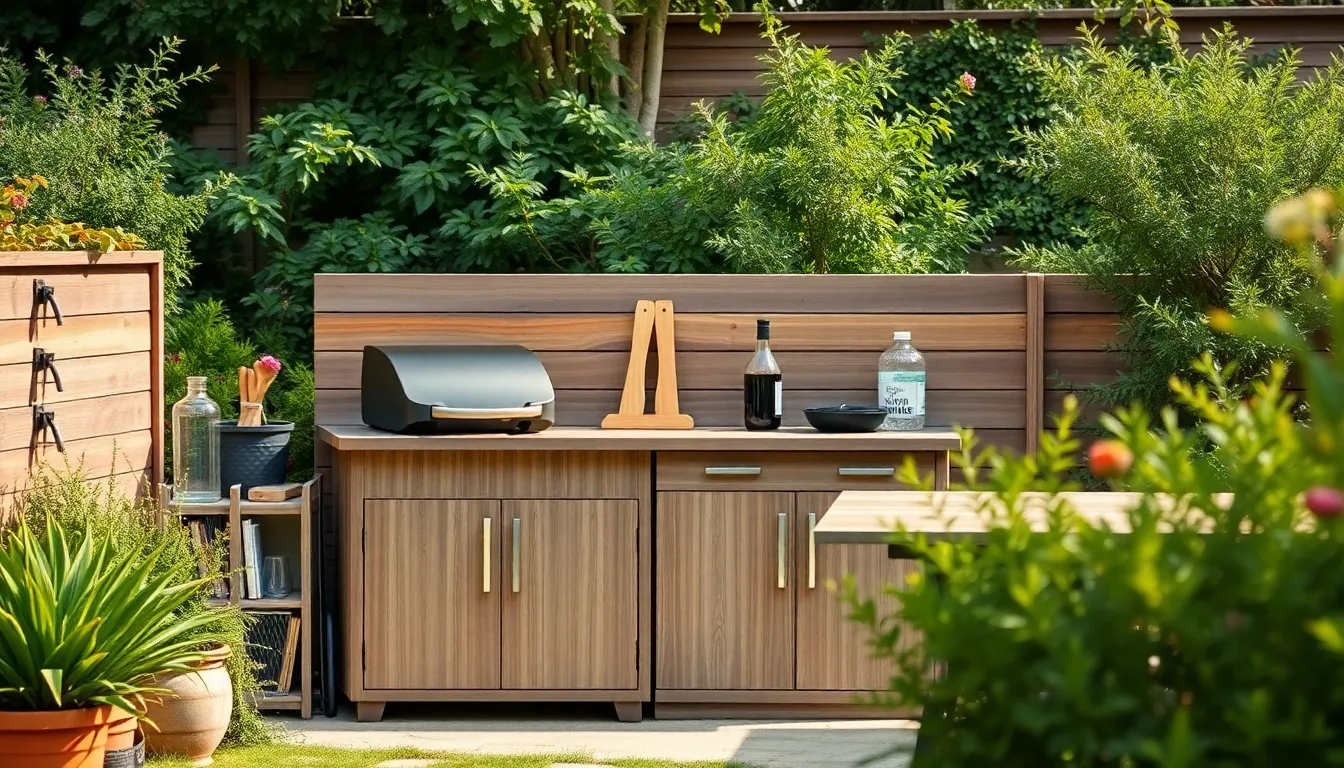
We’ll maximize every square foot of our small garden BBQ space by creating areas that serve multiple purposes throughout our outdoor cooking experience.
Combine BBQ with Prep Counter Space
Position prep counters directly adjacent to our grill to create an efficient workflow that keeps all essentials within arm’s reach. We recommend installing slim, elongated counters rather than bulky L-shaped configurations since they provide sufficient workspace without overwhelming compact areas.
Arrange our grill along a wall with counter space beside it and place the dining area directly in front. This strategic layout offers both styling flexibility and functional efficiency while maintaining clear pathways through our garden space.
Choose countertop materials that withstand outdoor elements like weather-resistant stone, stainless steel, or composite materials. We can extend these surfaces to create seamless transitions between cooking and serving zones.
Integrate Storage Answers into Your Design
Mount wall storage systems and shelves to keep BBQ tools, spices, and accessories organized while preserving valuable counter space. We’ll install these at comfortable heights for easy access during cooking sessions.
Use spaces beneath tables and counters for storage bins and compartments, especially when using tabletop grills. This approach maintains a tidy appearance while keeping fuel, dishes, and cooking tools readily available.
Install weather-resistant cabinets or storage boxes that blend with our garden’s aesthetic. We can choose from powder-coated metal units, teak storage benches, or built-in compartments that double as seating.
Add Fold-Down Tables for Extra Surface Area
Attach collapsible tables to BBQ areas or adjacent walls to create valuable surface space only when we need it. These space-saving answers prevent permanent clutter while providing flexibility for different occasions.
Transform fold-down surfaces into prep stations, serving areas, or buffet tables during grilling parties, then fold them away discreetly when not in use. We can mount these at various heights to accommodate different functions.
Select sturdy hinges and support brackets that handle the weight of food, dishes, and cooking equipment. We’ll ensure these tables lock securely in both open and closed positions for safety and reliability.
Transform Patio Spaces into BBQ Entertainment Hubs
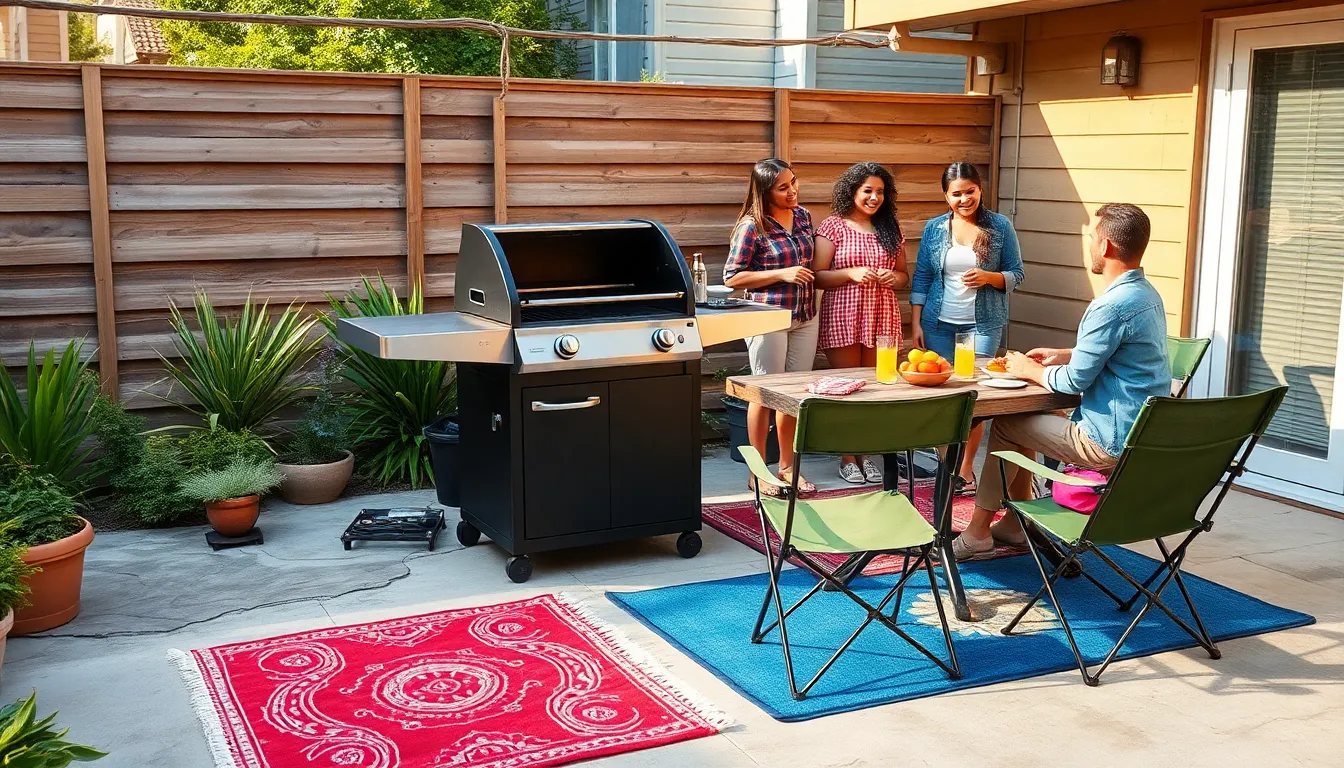
With thoughtful planning, we can turn any patio into a ever-changing outdoor cooking destination that maximizes both functionality and entertainment value.
Use Existing Concrete or Stone Surfaces
Leverage your current patio foundation for optimal grilling performance. Concrete and stone surfaces provide the ideal weather-resistant base for BBQ setups, offering durability that withstands heat exposure and food spills without deterioration. We recommend positioning grills directly on these existing surfaces to simplify cleanup routines and reduce fire hazards significantly.
Stone patios offer superior heat distribution properties that help maintain consistent cooking temperatures while protecting underlying structures. Concrete surfaces require minimal maintenance and can handle heavy grilling equipment without cracking or damage. These materials eliminate the need for additional protective barriers, saving both money and installation time.
Fire safety improves dramatically when we use non-combustible surfaces beneath our grilling stations. Both concrete and stone naturally resist ignition, creating a secure cooking environment that meets most local fire codes without additional modifications.
Create Defined Zones with Outdoor Rugs
Outdoor rugs transform chaotic patio spaces into organized entertainment areas by establishing clear boundaries between cooking, dining, and relaxation zones. We can visually separate these functional areas while adding comfort and style to hard patio surfaces.
Strategic rug placement prevents accidents by providing non-slip surfaces around hot grilling equipment and protecting guests’ feet from heated stone or concrete. Quality outdoor rugs withstand weather exposure while maintaining their appearance throughout multiple seasons.
Zone definition enhances guest flow by guiding people naturally between different activity areas without crowding the cooking space. We suggest using contrasting colors or patterns to highlight each zone’s exact purpose, making the entire patio feel larger and more purposeful.
Position Seating Around Your Grilling Area
Strategic seating arrangements encourage social interaction while keeping guests safely positioned away from active cooking zones. We recommend compact, multi-functional furniture like folding chairs, modular sets, and storage stools that accommodate varying group sizes without overwhelming small spaces.
Corner seating maximizes limited patio real estate by utilizing often-overlooked areas for built-in benches or L-shaped furniture configurations. These arrangements create intimate conversation areas while leaving central spaces open for movement and food preparation activities.
Multi-functional furniture pieces serve dual purposes by providing both seating and storage answers for BBQ tools, cushions, and outdoor accessories. Folding options allow us to quickly reconfigure spaces for different occasions, from intimate dinners to larger gatherings, while maintaining clear pathways around the grilling station.
Build Vertical BBQ Solutions for Tiny Gardens
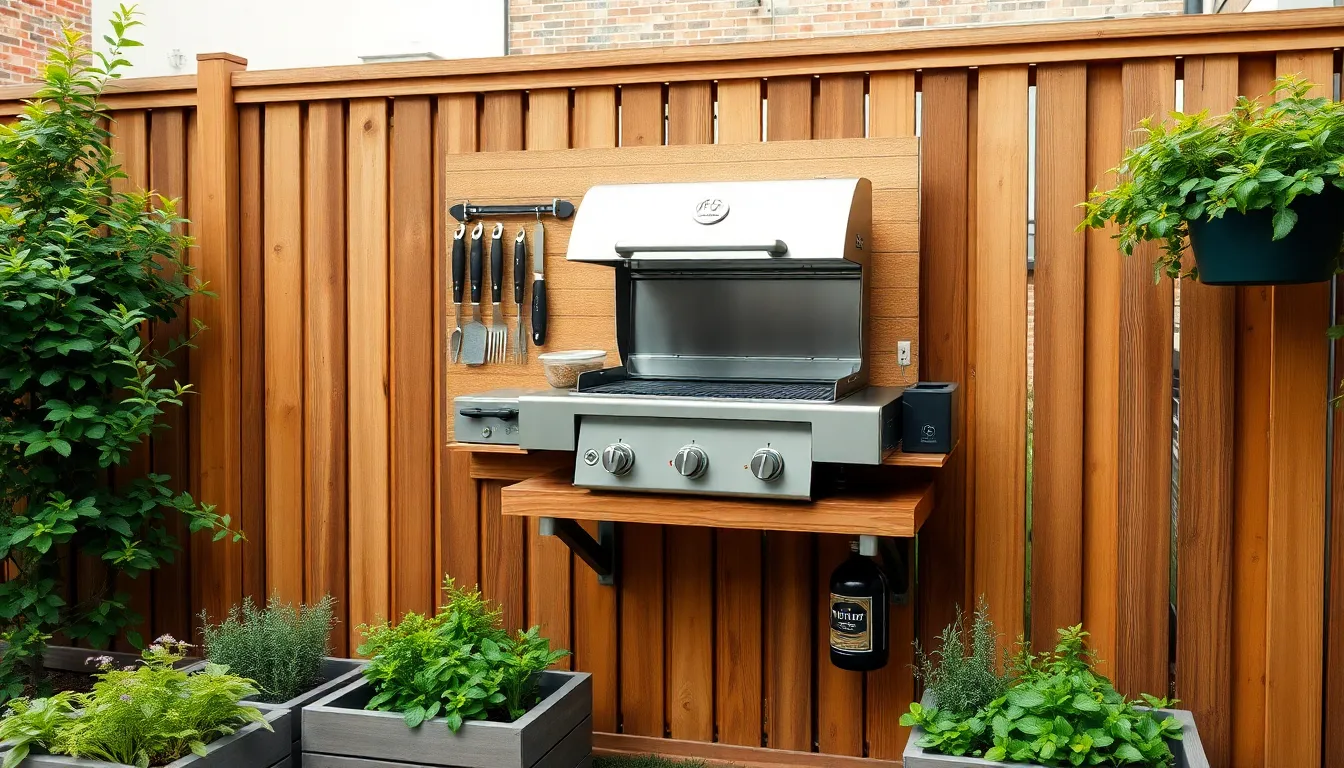
Building upward transforms even the smallest outdoor spaces into functional cooking areas. Vertical BBQ setups maximize your limited garden space by utilizing height rather than precious floor area.
Install Wall-Mounted Grilling Systems
Wall-mounted grills save valuable ground space while creating a sleek, modern cooking area. These systems attach directly to garden walls or fences, freeing up floor space for seating or movement around your outdoor area.
We recommend choosing models with fold-down prep counters that provide workspace when needed but stay compact when not in use. Built-in storage shelves keep grilling tools and seasonings within easy reach without cluttering your limited patio space.
Smart installation placement along narrow patios or balconies enables easy access during cooking while maintaining clear pathways. Wall-mounted systems work particularly well on sturdy fences or concrete walls that can support the weight of both the grill and cooking accessories.
Create Tiered Cooking Stations
Tiered cooking stations provide separate zones for grilling, prep, and serving stacked vertically rather than spread horizontally. Multi-level designs make efficient use of height to accommodate grills, utensils, and necessary gas or electrical connections.
We suggest building or purchasing units with graduated levels that create distinct cooking areas without overwhelming your small space. Upper shelves work perfectly for storing plates and serving dishes, while middle sections handle food preparation tasks.
Compact layouts designed for small backyard corners or balcony spaces often include integrated storage below the main cooking surface. These configurations allow you to keep charcoal, propane tanks, or cooking supplies organized and easily accessible.
Use Fence-Attached BBQ Setups
Fence-attached BBQ components offer practical answers for narrow spaces where traditional island setups won’t fit. BBQ grills, tool racks, and storage shelves can be securely fixed to existing fences without requiring additional floor space.
We find this arrangement keeps the cooking area centrally located and accessible without sacrificing precious walking or seating areas. Vertical herb gardens or planter boxes mounted nearby complement your BBQ setup while adding fresh cooking ingredients and natural ambiance.
Sturdy fence mounting ensures your equipment stays secure during use while maintaining the flexibility to reconfigure your setup as needed. This approach works especially well in urban gardens where every square foot counts toward creating an enjoyable outdoor cooking experience.
Incorporate Natural Elements into Your BBQ Design
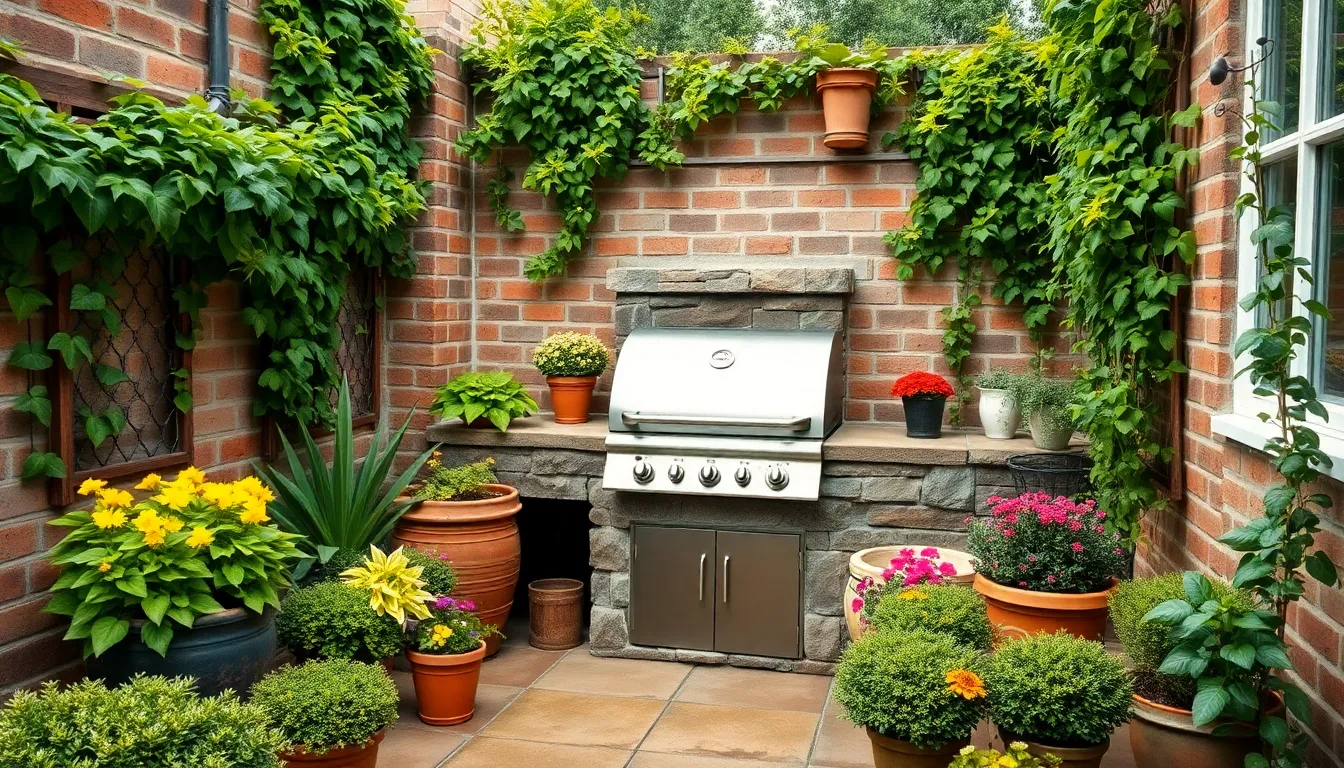
Natural elements transform small garden BBQ areas into inviting outdoor spaces that blend seamlessly with your industry. We’ll show you how to use plants, stone, and strategic greenery to create a functional yet beautiful cooking environment.
Use Stone and Brick for Rustic Appeal
Stone and brick materials offer timeless durability while creating visual appeal that anchors your BBQ area. These natural materials withstand outdoor conditions better than synthetic alternatives and provide excellent surfaces for grill placement and food preparation.
Stacked stone surrounds create stunning focal points around grilling stations while offering practical wind protection. We recommend using local stone varieties to match your garden’s existing hardscape elements and reduce material costs.
Brick countertops and cooking surfaces deliver rustic charm that complements garden settings perfectly. Installing brick or stone backsplashes behind wall-mounted grills protects surfaces while adding textural interest to compact cooking zones.
Surround Areas with Potted Plants
Potted plants soften harsh lines around BBQ equipment while adding color and fragrance to cooking spaces. We suggest positioning containers of varying heights around seating areas to create natural boundaries between different zones.
Clustering pots near grill stations provides easy access to fresh herbs like basil, rosemary, and thyme during cooking. Choose containers that match your stone or brick elements for cohesive design flow throughout the space.
Vertical planters maximize greenery in tight spaces without consuming valuable floor area. Installing wall-mounted plant containers or tiered plant stands creates lush backdrops that make small BBQ areas feel more spacious and garden-integrated.
Create Natural Windbreaks with Greenery
Dense shrubs and tall plants provide effective wind protection that improves cooking comfort and grill performance. We position these natural barriers strategically to shield flames from crosswinds while maintaining good ventilation around cooking areas.
Trellises with climbing plants create privacy screens that define BBQ zones without permanent structural additions. Fast-growing vines like clematis or jasmine quickly establish natural walls that block unwanted views and reduce noise from neighboring properties.
Evergreen plantings ensure year-round wind protection and visual screening for your outdoor cooking space. Selecting plants like boxwood or juniper provides consistent coverage while requiring minimal maintenance throughout changing seasons.
Design Budget-Friendly DIY BBQ Areas
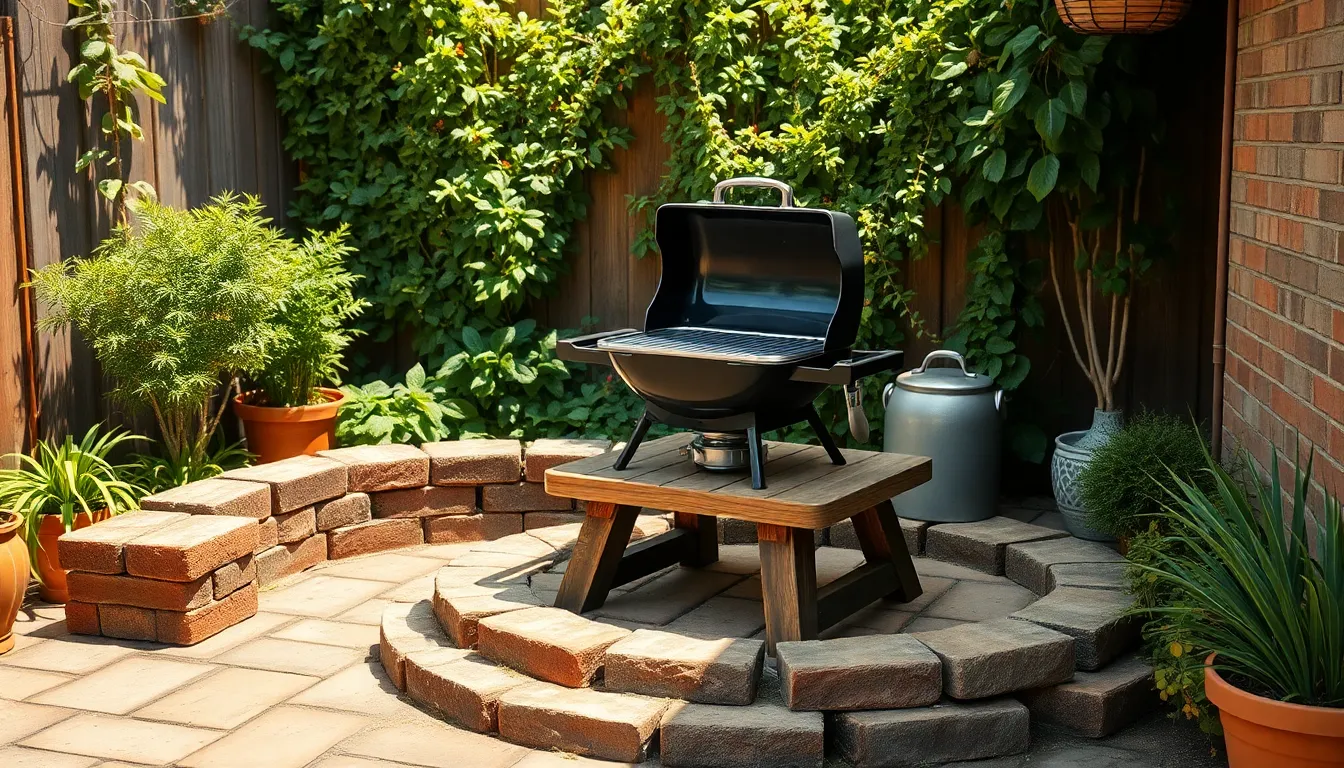
Creating an amazing BBQ space doesn’t require very costly. We can transform any small garden into a functional cooking zone by working smarter, not harder.
Repurpose Existing Garden Features
Existing patios provide the perfect foundation for BBQ areas without additional construction costs. We can easily convert paved corners or deck spaces into outdoor cooking zones by simply adding a portable or tabletop barbecue unit.
Garden benches transform into multi-functional BBQ stations with minimal effort. Adding a portable grill on top creates an instant cooking surface, while the bench base offers valuable storage space for utensils and charcoal.
Tables gain new life when we integrate BBQ functionality into their design. Converting an old garden table into a grill station maximizes our existing furniture investment while creating a dedicated cooking area.
Overlooked corners become intimate BBQ zones through strategic placement of compact grilling equipment. These forgotten spaces often provide natural windbreaks and create cozy gathering spots for outdoor entertaining.
Build Simple Gravel or Mulch Foundations
Gravel foundations offer an affordable alternative to expensive concrete or paving stones. This budget-friendly option provides excellent drainage while reducing weed growth around our BBQ area.
Mulch bases create a natural, rustic aesthetic that blends seamlessly with garden settings. These materials are DIY-friendly and allow us to reshape the foundation if our needs change over time.
Both gravel and mulch options eliminate the need for professional installation. We can easily spread these materials ourselves, saving hundreds of dollars in labor costs while achieving professional-looking results.
Drainage benefits make these foundation choices practical for year-round use. Unlike solid surfaces, gravel and mulch allow water to flow through naturally, preventing puddles and reducing maintenance requirements.
Use Recycled Materials for Creative Answers
Reclaimed bricks and stones create stunning BBQ surrounds at a fraction of new material costs. These weathered materials add character and authenticity to our outdoor cooking space while promoting sustainable building practices.
Old garden furniture transforms into functional BBQ accessories through creative repurposing. We can convert worn tables into prep stations, benches into storage units, or chairs into plant stands around our grilling area.
Wood pallets provide versatile building materials for BBQ stands, shelves, and storage answers. These free or low-cost items can be dismantled and reconstructed into custom pieces that fit our exact space requirements.
Scrap metal pieces become unique lighting fixtures or decorative elements around our BBQ zone. Combining different recycled materials creates a one-of-a-kind outdoor space that reflects our personal style while staying within budget.
Maximize Safety in Compact BBQ Spaces
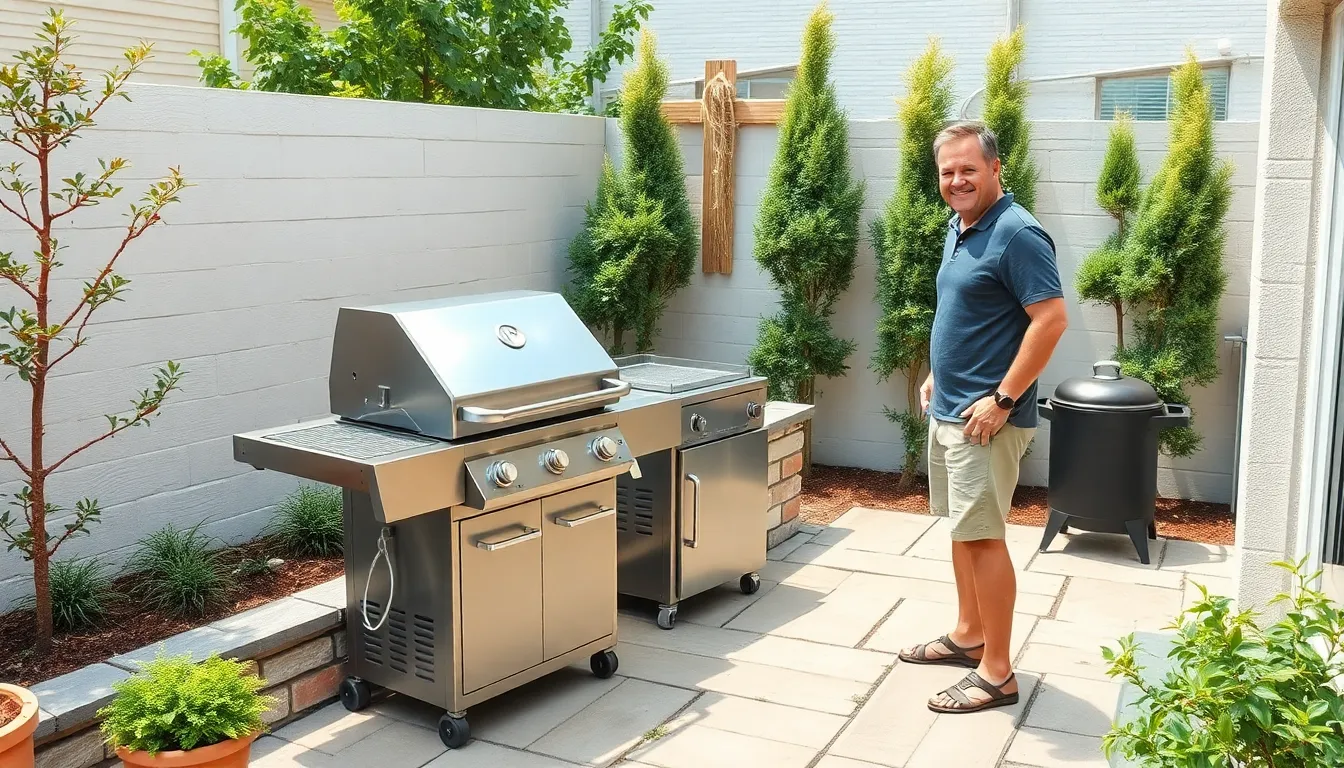
Creating a safe BBQ environment becomes even more critical when we’re working with limited outdoor space. Every safety measure we carry out helps protect our property and ensures our guests can enjoy memorable outdoor cooking experiences.
Maintain Proper Clearance from Structures
We must position our BBQ grill at least several feet away from our house, fences, and any flammable structures to prevent accidental fires. Gas barbecues require extra attention since they emit heat from the rear, making adequate clearance behind the unit essential for preventing heat damage to nearby surfaces.
Measuring the distance from our grill to surrounding structures helps us avoid costly property damage while ensuring proper ventilation. We should also consider the height clearance, keeping grills away from overhanging eaves, pergolas, or covered patios that could trap heat and create fire hazards.
Install Fire-Safe Flooring Materials
Using non-combustible materials such as concrete, stone pavers, or brick for the flooring under and around our BBQ area minimizes fire hazards significantly. These materials create a protective barrier that prevents stray sparks from igniting surrounding surfaces and provide a stable base for our grilling equipment.
We should avoid placing grills on wooden decks or dry grass, as sparks can easily ignite these combustible surfaces. Stone pavers offer an attractive alternative that combines safety with aesthetic appeal, while concrete provides the most durable and cost-effective fire-resistant foundation for our small garden BBQ space.
Position BBQ Areas Away from Plants
Keeping our BBQ grills clear of overhanging branches, plants, and shrubs reduces the risk of fire from stray flames or hot grease splatters. We need to trim back any vegetation that extends within several feet of our grilling area to create a safe cooking zone.
Dense plantings and dry foliage can quickly ignite from heat or sparks, making proper spacing between our grill and garden plants essential for fire prevention. We can still enjoy greenery around our BBQ area by choosing fire-resistant plants and positioning them at safe distances from our cooking equipment.
Add Lighting and Ambiance to Small BBQ Zones
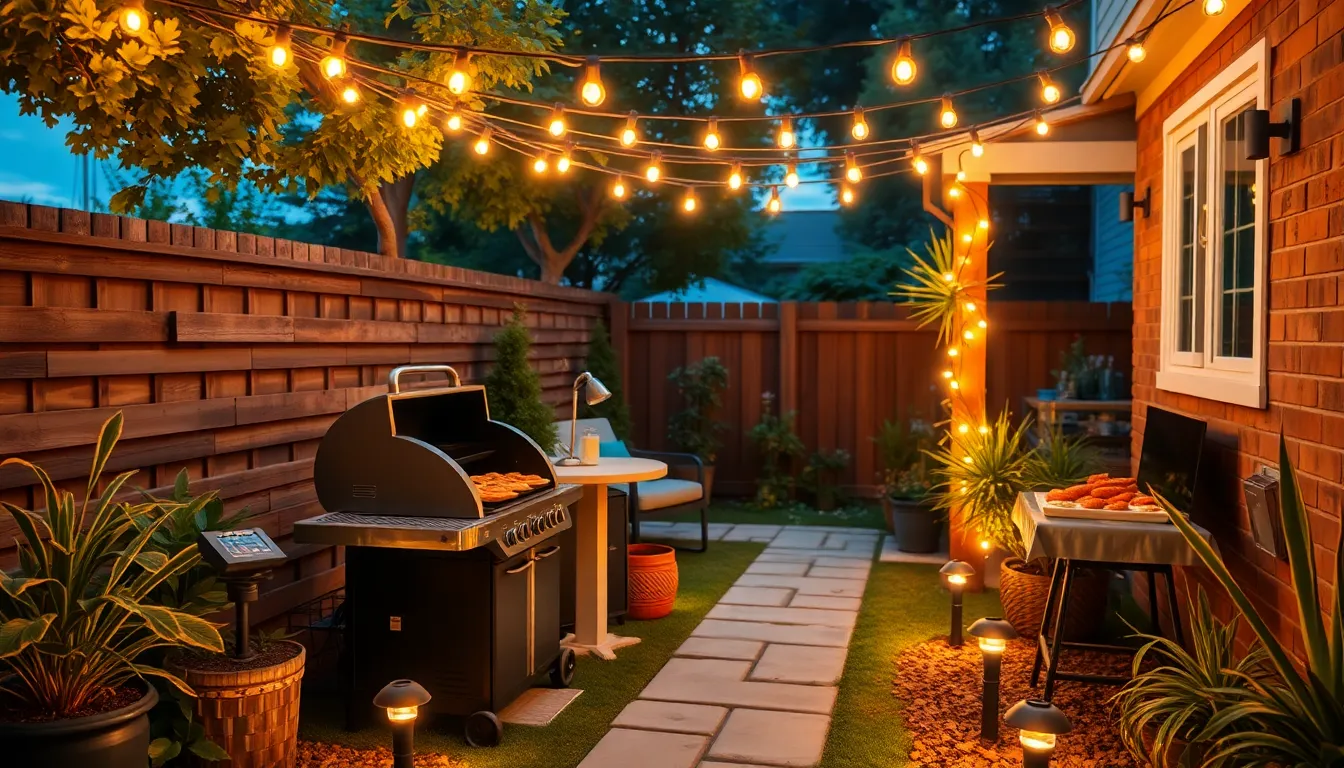
Creating the right atmosphere in your compact BBQ area transforms evening grilling into memorable outdoor experiences. Proper lighting ensures safety while adding warmth and style to your intimate cooking space.
Install Solar-Powered Garden Lights
Solar lights offer the perfect energy-efficient solution for illuminating small BBQ zones without complicated wiring projects. We recommend placing these sustainable fixtures along pathways leading to your grilling area and around the perimeter of your cooking space. Installation takes minutes since these lights simply stake into the ground or mount on existing structures.
These eco-friendly options automatically charge during daylight hours and provide consistent illumination throughout evening cooking sessions. Position solar spotlights near your grill station for focused task lighting while using solar lanterns to create ambient lighting around seating areas. Most quality solar garden lights deliver 6-8 hours of operation after a full day’s charge.
Use String Lights for Cozy Atmosphere
String lights instantly transform any small BBQ area into an inviting outdoor retreat with their warm, decorative glow. We suggest hanging them overhead between trees, fence posts, or pergola beams to create a magical canopy effect above your cooking zone. Edison bulb string lights provide vintage charm while LED versions offer longer lifespan and lower energy consumption.
These versatile lights can wrap around existing structures like railings, umbrellas, or even your BBQ station itself for added visual interest. Choose weatherproof options specifically designed for outdoor use to ensure durability through various weather conditions. Dimmer controls allow you to adjust brightness levels from bright task lighting during food prep to soft ambient lighting during dining.
Position Task Lighting for Evening Cooking
Task lighting ensures safe and efficient nighttime grilling by providing focused illumination exactly where you need it most. We recommend installing LED spotlights or adjustable lamps directly above your grill and prep station to eliminate shadows while cooking. These targeted light sources help you monitor food doneness and handle sharp utensils safely in low light conditions.
Mount adjustable LED fixtures on nearby walls or posts to direct light precisely onto your cooking surface without creating glare. Battery-powered grill lights that clip directly onto BBQ equipment offer portable answers for renters or those avoiding permanent installations. Position prep station lighting at counter height to illuminate cutting boards and ingredient bowls effectively during evening meal preparation.
Conclusion
Creating a functional BBQ area in your small garden doesn’t require a massive budget or extensive space. We’ve shown you how smart planning and creative answers can transform even the tiniest outdoor areas into inviting cooking zones.
From vertical grilling systems to repurposed materials these strategies prove that size limitations shouldn’t stop you from enjoying outdoor cooking. Remember to prioritize safety while incorporating natural elements and proper lighting to enhance your space’s appeal.
Your small garden BBQ area can become the perfect spot for memorable gatherings. With these practical ideas you’re well-equipped to design an outdoor cooking space that maximizes every square foot while staying within your budget.
Frequently Asked Questions
Can I create a BBQ area in a very small garden?
Yes, absolutely! Even the smallest gardens can accommodate a BBQ area with smart planning. Focus on vertical solutions like wall-mounted grills, use multi-functional furniture, and maximize corners. Transform existing patios into cooking zones and consider compact, space-saving equipment that folds away when not in use.
What’s the best flooring for a small BBQ area?
Concrete, stone, or brick flooring works best for BBQ areas. These non-combustible materials provide excellent fire safety, are easy to clean, and offer durability. For budget-friendly options, consider gravel or mulch foundations, which provide good drainage and a rustic aesthetic.
How can I make my small BBQ space look bigger?
Use outdoor rugs to define different zones, install vertical planters to save floor space, and choose light-colored materials that reflect light. Strategic lighting with string lights or solar garden lights creates depth, while mirrors on fence walls can create an illusion of expanded space.
What safety clearances do I need for a small BBQ setup?
Maintain at least 3 feet clearance from structures and flammable materials. Keep grills away from overhanging plants, use non-combustible flooring, and ensure proper ventilation. Position fire-resistant plants at safe distances and always have a fire extinguisher nearby for emergency situations.
How much does it cost to create a small garden BBQ area?
Budget-friendly BBQ areas can cost as little as $200-500 using DIY approaches. Repurpose existing furniture, use recycled materials like reclaimed bricks or pallets, and build simple gravel foundations. Focus on essential elements first: grill, prep surface, and basic seating.
What lighting works best for evening BBQ sessions?
Combine task lighting with ambient lighting for optimal results. Install LED spotlights or adjustable lamps over grilling and prep areas for safety. Add string lights or solar-powered garden lights for atmosphere. Battery-operated LED lights offer flexibility without requiring electrical work.
Can I use my existing patio for BBQ entertaining?
Yes, patios make excellent BBQ bases! The concrete or stone surface provides ideal fire safety and easy cleanup. Use outdoor rugs to define cooking, dining, and relaxation zones. Add portable furniture and storage solutions to transform your patio into a complete entertainment hub.
What plants work well around BBQ areas?
Choose fire-resistant plants positioned at safe distances from cooking equipment. Potted herbs provide easy access for cooking while staying mobile. Use dense shrubs as natural windbreaks for comfort and privacy. Vertical planters maximize greenery without taking up valuable floor space.

